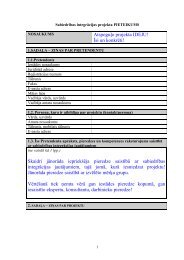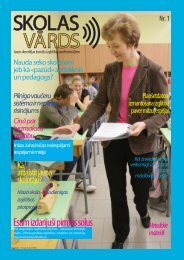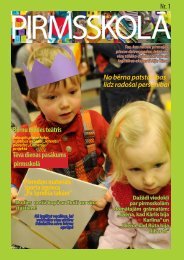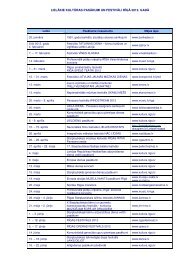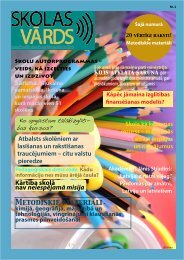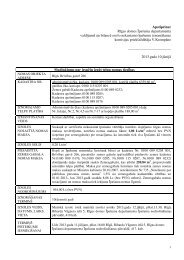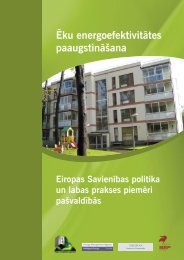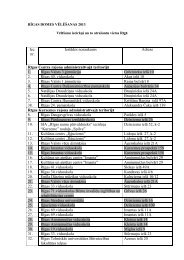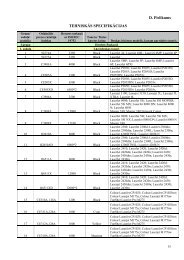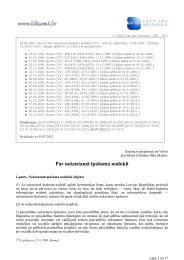Riga - European Capital of Culture 2014 candidate
Riga - European Capital of Culture 2014 candidate
Riga - European Capital of Culture 2014 candidate
- No tags were found...
You also want an ePaper? Increase the reach of your titles
YUMPU automatically turns print PDFs into web optimized ePapers that Google loves.
Amber embodies a paradox. On the one hand, it is an inertrock and a component <strong>of</strong> inorganic nature. But on the otherhand, amber is a relic <strong>of</strong> the living past, a piece <strong>of</strong> organicmatter, and the lifeline <strong>of</strong> plant life. As a mineral, amber, likeall stones, is eternal, quite unlike the transitory elements<strong>of</strong> human existence. But as a prehistoric plant extract, amberreawakens in our modern-day consciousness a sense<strong>of</strong> eternal return, traditional cycles <strong>of</strong> reawakening – likethe seasons, the path <strong>of</strong> the sun, and the spiral <strong>of</strong> humanlife, which repeats the same model for generations. Amberhas a new symbolic value in the consciousness <strong>of</strong> today’sidentity, aware <strong>of</strong> traditions that aren’t just dead and gonebut, rather, are tangible pro<strong>of</strong> <strong>of</strong> something indestructiblyalive. 1“Amber Vein” is a thematic line that will reveal those scientific andcultural achievements that are valuable both as excellent accomplishmentsand as remarkable contributions to the global community.This is <strong>Riga</strong>’s and Latvia’s investment in world culture andthe development <strong>of</strong> human creativity. As part <strong>of</strong> the <strong>European</strong><strong>Capital</strong> <strong>of</strong> <strong>Culture</strong> programme, the “New Amber Route” will bea <strong>European</strong> cultural cooperation network created by the city <strong>of</strong><strong>Riga</strong>, which will unite the cities in the ancient amber trade route ina new, interdisciplinary partnership. Why did we choose amber forthis thematic section? What’s so special about this natural mineralthat people living along the Baltic coast have grown so accustomedto in everyday life? Amber is a virgin element that containsthe code <strong>of</strong> evolution.Amber: A ‘Child <strong>of</strong> Nature’ created under the influence <strong>of</strong> aclimatic force majeureDzintars, the Latvian word for ‘amber’, comes from the Latinsuccinus; the English word ‘amber’ stems from the ancient Persianambare. Amber has been given many other beautiful names in variouslanguages: in Latvian, dzintars is the ‘sun stone’; in Russian,alatir is ‘sea incense’; and in Finnish, Estonian, and Arab, amber is‘sea stone.’ People in various time periods have always believedin the mysterious powers <strong>of</strong> amber, regardless <strong>of</strong> what they calledit. Amber is usually yellow with various other subtle colour tones,from yellowish red to yellowish brown. White, green, and blackamber may also be found. Researchers have claimed that ambercan come in 216 different colours.The first written testimony <strong>of</strong> amber appeared in Assyrian cuneiformcharacters, in 1000 B.C. The first person to mention the plantorigin <strong>of</strong> amber was the ancient Roman historian Pliny the Elder(23–79 AD), who concluded that amber was composed <strong>of</strong> resinthat had hardened in the cold. Now most researchers agree that,about 50–60 million years ago, when the Scandinavian Peninsulawas attached to the eastern shore <strong>of</strong> the Baltic Sea, the foreststhat gave rise to amber grew on the coast <strong>of</strong> the North Sea. Atthat time, the climate in this region was similar to that <strong>of</strong> moderndayAfrica, and the subtropical and tropical forests were homemostly to palms, cypresses, oaks, chestnuts, pines, and firs. Inthese forests, pine trees (pinus succinifera) secreted a wealth <strong>of</strong>resin. During storms and other atmospheric disturbances, thisresin ended up in the water, where it hardened and was eventuallycarried south. What we call amber is no longer primordial resin; itis a mineral that has formed over a long period <strong>of</strong> time.As the earth’s climate changed and the temperature rose, plantsin extreme conditions began to produce more and more succinicacid, which found its way into resin. More developed organismstried to use external sources to make up for the deficiencies in thissubstance. This is perhaps why many insects were instinctivelyattracted to liquid wood resin, where they drowned and in whichthey have been preserved to the present day.Amber on the scale <strong>of</strong> valuesThe Romans valued Baltic amber so highly that a piece <strong>of</strong> amberthe size <strong>of</strong> a child’s fist was worth more than a healthy youngslave. Their predecessors the Villanovans and Etruscans (1200–600 B.C.) considered amber more valuable than gold. And duringthe Bronze age, 3,500 years ago, Baltic amber was consideredthe main precious mineral in all Mediterranean civilizations – theGreeks, the Minoans, and the Egyptians. A few examples: WhenHeinrich Schliemann discovered the ruins <strong>of</strong> Troy he also found10,000 amber beads. In 1922, when Howard Carter found thetomb <strong>of</strong> Tutankhamen, he had no idea that the dull brown resinin the middle <strong>of</strong> the golden ‘heart scarab’ (the single most importantjewel on the pharaoh’s mummy) was amber, the ‘sun stone’,as was the necklace in his casket. In the Old Testament, KingSolomon’s ring was made <strong>of</strong> amber, and Baltic amber beads havebeen found in archaeological sites in the Near East dating from3500 and 4200 B.C. 2Healing propertiesThe Ancient Egyptians knew that amber had unique healingpowers. In Ancient Egypt, resin was an ingredient in embalming substances.The Egyptians also prepared a drink from amber groundinto powder, which they then mixed with wine and honey and usedto strengthen the heart and other organs. Pliny the Elder (23–79A.D.) wrote that Italian women wore amber around their necks, toprotect against an enlarged thyroid gland and other throat diseases.These so-called ‘health necklaces’ – uncut amber threaded on alinen thread – are still worn today by women in the Baltic States. InBelarus, amber was used to treat insomnia; pieces <strong>of</strong> uncut amberwere placed beneath the pillow or hung at the head <strong>of</strong> the bed. Tothis day, amber spirit extract is used to treat and prevent colds, variousheart conditions, and circulation problems.The transformation <strong>of</strong> amber in new scientific discoveriesAmber has its own DNA. By analyzing the chemical componentsand radioactive carbon data <strong>of</strong> a piece <strong>of</strong> amber, scientists candetermine whether the amber comes from the Baltic coast or otherlocations. Scientists call amber from the Baltic region succinites.Inga Ļašenko, a researcher at the Biomaterial and BiomechanicsInstitute at <strong>Riga</strong> Technical University, is the most outstandingspecialist in modern ‘amber science’ well beyond <strong>Riga</strong> andLatvia’s borders. She has won two prestigious awards: a GoldMedal for Innovation and a Gold Medal for Science from theWorld Intellectual Property Organization. These medals provethe importance <strong>of</strong> I. Ļašenko’s work in the development <strong>of</strong> newinnovations and confirm its great practical significance. Thescientist conducts experiments in the construction <strong>of</strong> amber bloodvessels, which may someday be used in heart and blood vesselsurgery. At the Egyptian National Library in Cairo, I. Ļašenko discovereda manuscript that tells <strong>of</strong> Egyptian efforts to make bloodvessels from amber, two thousands years ago. I. Ļašenko’s firstdiscoveries show that an amber electron donor with a negativeelectric charge considerably lessens the formation <strong>of</strong> thrombi inblood vessels, which is the problem with traditional implants. Shehas also created composite amber threads that can be used bothfor medical purposes and for textile products. Likewise, Pr<strong>of</strong>essorĻašenko has developed a line <strong>of</strong> amber-based natural cosmetics,which provide surprising effects.The eternal art <strong>of</strong> amberFor centuries, amber has served both as an object <strong>of</strong> beauty andpro<strong>of</strong> <strong>of</strong> one’s social status: the more ornate the amber decorationson a person’s clothing and jewellery, the more influential he or shewas in society. At the end <strong>of</strong> the Stone Age, people most <strong>of</strong>ten usedamber to make necklaces; this is confirmed by archaeological discoverieson the Baltic coast, in Scandinavia, and in a few regions<strong>of</strong> Ukraine. In the late Stone Age, amber was carried farther intoEurope, where the craft <strong>of</strong> amber processing was established – thepractice <strong>of</strong> cutting, boring, and polishing. During this time amberwas also brought into Egypt, where it was used to make jewelleryand other cult objects.106 107



